
Concept explainers
(a)
Interpretation:
The bonding and anti-bonding combinations
Concept introduction:
The linear combination of atomic orbital (LCAO) states that two atomic orbitals combine together to form a new orbital which is known as bonding molecular orbital.
The molecular orbital theory also states that two atoms combines together to form a molecule. During the formation of a molecule, the electrons are shared between two atoms to form a
Answer to Problem 1.47AP
The bonding and anti-bonding combinations
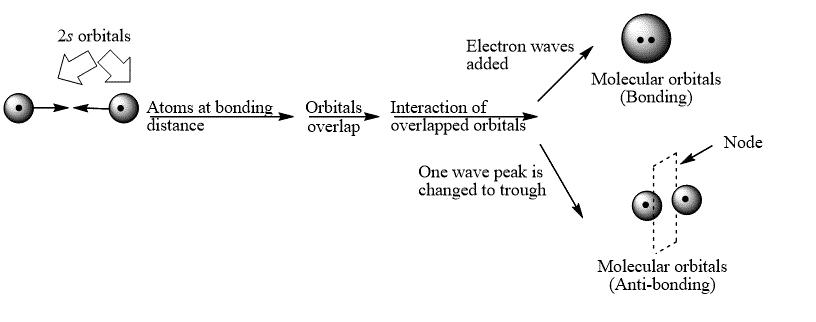
Explanation of Solution
The bond electrons which on addition form a molecular orbital are known as bonding electrons.
The bond electrons which on subtraction form a molecular orbital are known as anti-bonding electrons.
The bonding and anti-bonding combinations for the interaction of two

Figure 1
The bonding and anti-bonding molecular orbital are obtained by the overlapping of two
The bonding and anti-bonding combinations
(b)
Interpretation:
The bonding and anti-bonding combinations
Concept introduction:
The linear combination of atomic orbital (LCAO) states that two atomic orbitals combine together to form a new orbital which is known as bonding molecular orbital.
The molecular orbital theory also states that two atoms combines together to form a molecule. During the formation of a molecule, the electrons are shared between two atoms to form a chemical bond.
Answer to Problem 1.47AP
The bonding and anti-bonding combinations

Explanation of Solution
The bond electrons which on addition form a molecular orbital are known as bonding electrons.
The bond electrons which on subtraction form a molecular orbital are known as anti-bonding electrons.
The bonding and anti-bonding combinations for the interaction of two
 Figure 2
Figure 2
The bonding and anti-bonding molecular orbital are obtained by the overlapping of two
The bonding and anti-bonding combinations
(c)
Interpretation:
The bonding and anti-bonding combinations
Concept introduction:
The linear combination of atomic orbital (LCAO) states that two atomic orbitals combine together to form a new orbital which is known as bonding molecular orbital.
The molecular orbital theory also states that two atoms combines together to form a molecule. During the formation of a molecule, the electrons are shared between two atoms to form a chemical bond.
Answer to Problem 1.47AP
The bonding and anti-bonding combinations
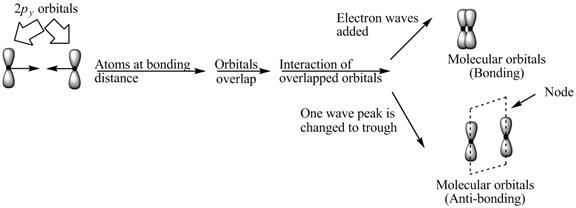
Explanation of Solution
The bond electrons which on addition form a molecular orbital are known as bonding electrons.
The bond electrons which on subtraction form a molecular orbital are known as anti-bonding electrons.
The bonding and anti-bonding combinations for the interaction of two
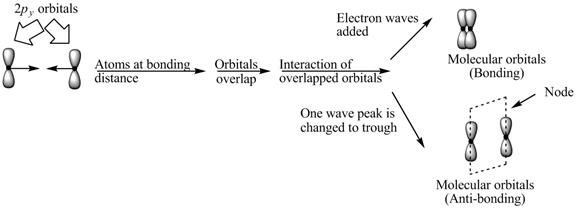
Figure 3
The bonding and anti-bonding molecular orbital are obtained by the overlapping of two
The bonding and anti-bonding combinations
(d)
Interpretation:
The bonding and anti-bonding combinations
Concept introduction:
The linear combination of atomic orbital (LCAO) states that two atomic orbitals combine together to form a new orbital which is known as bonding molecular orbital.
The molecular orbital theory also states that two atoms combines together to form a molecule. During the formation of a molecule, the electrons are shared between two atoms to form a chemical bond.
Answer to Problem 1.47AP
The bonding and anti-bonding combinations
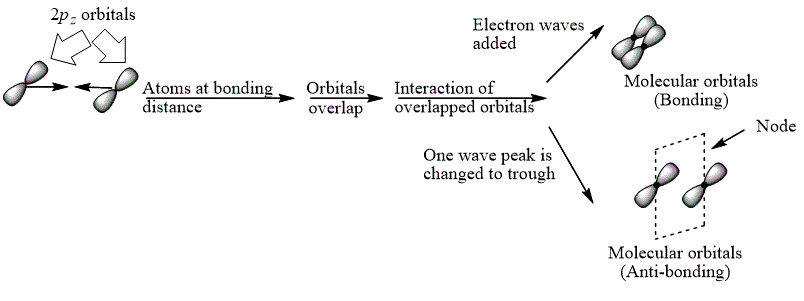
Explanation of Solution
The bond electrons which on addition form a molecular orbital are known as bonding electrons.
The bond electrons which on subtraction form a molecular orbital are known as anti-bonding electrons.
The bonding and anti-bonding combinations for the interaction of two

Figure 4
The bonding and anti-bonding molecular orbital are obtained by the overlapping of two
The bonding and anti-bonding combinations
(e)
Interpretation:
The orbital interaction energy diagram showing the energy levels of the atomic orbitals along with the energies of the given MOs is to be drawn.
Concept introduction:
The linear combination of atomic orbital (LCAO) states that two atomic orbitals combine together to form a new orbital which is known as bonding molecular orbital.
The molecular orbital theory also states that two atoms combines together to form a molecule. During the formation of a molecule, the electrons are shared between two atoms to form a chemical bond.
Answer to Problem 1.47AP
The orbital interaction energy diagram showing the energy levels of the atomic orbitals along with the energies of the given MOs is represented below.
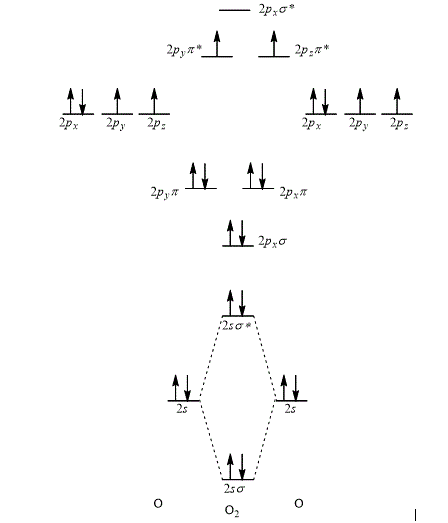
Explanation of Solution
According to the rules for filling the electrons in the molecular orbital, first of all the lower energy molecular orbital is filled followed by the filling of increasing energy order of the molecular orbital.
Thus, the orbital interaction energy diagram showing the energy levels of the atomic orbitals along with the energies of the given MOs of oxygen atom is shown as,

Figure 5
The energy of sigma,
The orbital interaction energy diagram showing the energy level of the atomic orbitals along with the energies of the given MOs is shown Figure 5.
(f)
Interpretation:
The reason corresponding to the fact that liquid
Concept introduction:
The atoms which contain no unpaired electron in their orbital and have total spin equals to zero are known as diamagnetic atoms. The atoms which contain one or more unpaired electron in their orbital are known as paramagnetic atoms.
Answer to Problem 1.47AP
The liquid
Explanation of Solution
In oxygen molecule, two unpaired electrons are present in the anti-bonding molecular orbital. Thus, oxygen molecule is paramagnetic in nature due to which it gets attracted towards the magnetic field.
In comparison to liquid oxygen, the movement of the oxygen gas molecules is faster. Therefore, liquid oxygen molecules are not attracted by the magnetic field.
Hence, liquid
The reason corresponding to the fact that liquid
(g)
Interpretation:
The Lewis structure that best describes the covalent bond(s) in
Concept introduction:
The Lewis structure shows the connectivity between atoms by identifying the lone pairs of electrons in a compound. Lewis structures are also called Lewis dot structures. The valence electrons around an atom are shown by dots. Bonds between atoms are shown by lines and the lone pair of electrons is shown by a pair of dots.
Answer to Problem 1.47AP
The Lewis structure that best describes the covalent bond(s) in
![]()
Explanation of Solution
The given Lewis structures of
The reason corresponding to the fact that liquid

Figure 6
The total number of bonding electrons in
The total number of anti-bonding electrons in
The bond order of
Substitute the number of bonding molecular orbital and anti-bonding molecular orbital electrons in the above expression.
Thus, the bond order of oxygen molecule is
Therefore, the Lewis structures of
In option D, the Lewis structures of
In option A, the Lewis structures of

Figure 7
The Lewis structure that best describes the covalent bond(s) in
Want to see more full solutions like this?
Chapter 1 Solutions
Organic Chemistry Study Guide and Solutions
- Predict the products of this organic reaction: H3O+ + ? • Draw all the reasonable products in the drawing area below. If there are no products, because no reaction will occur, check the box under the drawing area. • Include both major and minor products, if some of the products will be more common than others. • Be sure to use wedge and dash bonds if you need to distinguish between enantiomers. No reaction. Click and drag to start drawing a structure. dmarrow_forwardIarrow_forwardDraw the anti-Markovnikov product of the hydration of this alkene. this problem. Note for advanced students: draw only one product, and don't worry about showing any stereochemistry. Drawing dash and wedge bonds has been disabled for esc esc ☐ Explanation Check F1 1 2 F2 # 3 F3 + $ 14 × 1. BH THE BH3 2. H O NaOH '2 2' Click and drag to start drawing a structure. F4 Q W E R A S D % 905 LL F5 F6 F7 © 2025 McGraw Hill LLC. All Rights Reserved. Terms of Use | Privacy Center | Accessibility < & 6 7 27 8 T Y U G H I F8 F9 F10 F11 F12 9 0 J K L P + // command option Z X C V B N M H H rol option commandarrow_forward
- AG/F-2° V 3. Before proceeding with this problem you may want to glance at p. 466 of your textbook where various oxo-phosphorus derivatives and their oxidation states are summarized. Shown below are Latimer diagrams for phosphorus at pH values at 0 and 14: -0.93 +0.38 -0.50 -0.51 -0.06 H3PO4 →H4P206 →H3PO3 →→H3PO₂ → P → PH3 Acidic solution Basic solution -0.28 -0.50 3--1.12 -1.57 -2.05 -0.89 PO HPO H₂PO₂ →P → PH3 -1.73 a) Under acidic conditions, H3PO4 can be reduced into H3PO3 directly (-0.28V), or via the formation and reduction of H4P206 (-0.93/+0.38V). Calculate the values of AG's for both processes; comment. (3 points) 0.5 PH P 0.0 -0.5 -1.0- -1.5- -2.0 H.PO, -2.3+ -3 -2 -1 1 2 3 2 H,PO, b) Frost diagram for phosphorus under acidic conditions is shown. Identify possible disproportionation and comproportionation processes; write out chemical equations describing them. (2 points) H,PO 4 S Oxidation stale, Narrow_forward4. For the following complexes, draw the structures and give a d-electron count of the metal: a) Tris(acetylacetonato)iron(III) b) Hexabromoplatinate(2-) c) Potassium diamminetetrabromocobaltate(III) (6 points)arrow_forward2. Calculate the overall formation constant for [Fe(CN)6]³, given that the overall formation constant for [Fe(CN)6] 4 is ~1032, and that: Fe3+ (aq) + e = Fe²+ (aq) E° = +0.77 V [Fe(CN)6]³ (aq) + e¯ = [Fe(CN)6] (aq) E° = +0.36 V (4 points)arrow_forward
- 5. Consider the compounds shown below as ligands in coordination chemistry and identify their denticity; comment on their ability to form chelate complexes. (6 points) N N A B N N N IN N Carrow_forward1. Use standard reduction potentials to rationalize quantitatively why: (6 points) (a) Al liberates H2 from dilute HCl, but Ag does not; (b) Cl2 liberates Br2 from aqueous KBr solution, but does not liberate C12 from aqueous KCl solution; c) a method of growing Ag crystals is to immerse a zinc foil in an aqueous solution of AgNO3.arrow_forwardWhat would be the best choices for the missing reagents 1 and 3 in this synthesis? 1 1. PPh3 2. n-BuLi 3 2 • Draw the missing reagents in the drawing area below. You can draw them in any arrangement you like. • Do not draw the missing reagent 2. If you draw 1 correctly, we'll know what it is. • Note: if one of your reagents needs to contain a halogen, use bromine. Click and drag to start drawing a structure. Xarrow_forward
- What is the missing reactant R in this organic reaction? N N H3O+ +R + • Draw the structure of R in the drawing area below. • Be sure to use wedge and dash bonds if it's necessary to draw one particular enantiomer. Click and drag to start drawing a structure. fmarrow_forwardThe product on the right-hand side of this reaction can be prepared from two organic reactants, under the conditions shown above and below the arrow. Draw 1 and 2 below, in any arrangement you like. 1+2 NaBH3CN H+ N Click and drag to start drawing a structure. 5arrow_forwardAssign this HSQC Spectrum ( please editing clearly on the image)arrow_forward
 Chemistry & Chemical ReactivityChemistryISBN:9781337399074Author:John C. Kotz, Paul M. Treichel, John Townsend, David TreichelPublisher:Cengage Learning
Chemistry & Chemical ReactivityChemistryISBN:9781337399074Author:John C. Kotz, Paul M. Treichel, John Townsend, David TreichelPublisher:Cengage Learning Chemistry & Chemical ReactivityChemistryISBN:9781133949640Author:John C. Kotz, Paul M. Treichel, John Townsend, David TreichelPublisher:Cengage Learning
Chemistry & Chemical ReactivityChemistryISBN:9781133949640Author:John C. Kotz, Paul M. Treichel, John Townsend, David TreichelPublisher:Cengage Learning General Chemistry - Standalone book (MindTap Cour...ChemistryISBN:9781305580343Author:Steven D. Gammon, Ebbing, Darrell Ebbing, Steven D., Darrell; Gammon, Darrell Ebbing; Steven D. Gammon, Darrell D.; Gammon, Ebbing; Steven D. Gammon; DarrellPublisher:Cengage Learning
General Chemistry - Standalone book (MindTap Cour...ChemistryISBN:9781305580343Author:Steven D. Gammon, Ebbing, Darrell Ebbing, Steven D., Darrell; Gammon, Darrell Ebbing; Steven D. Gammon, Darrell D.; Gammon, Ebbing; Steven D. Gammon; DarrellPublisher:Cengage Learning Chemistry: Principles and ReactionsChemistryISBN:9781305079373Author:William L. Masterton, Cecile N. HurleyPublisher:Cengage Learning
Chemistry: Principles and ReactionsChemistryISBN:9781305079373Author:William L. Masterton, Cecile N. HurleyPublisher:Cengage Learning Chemistry: Principles and PracticeChemistryISBN:9780534420123Author:Daniel L. Reger, Scott R. Goode, David W. Ball, Edward MercerPublisher:Cengage Learning
Chemistry: Principles and PracticeChemistryISBN:9780534420123Author:Daniel L. Reger, Scott R. Goode, David W. Ball, Edward MercerPublisher:Cengage Learning





